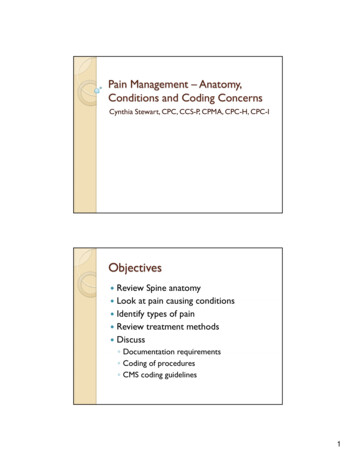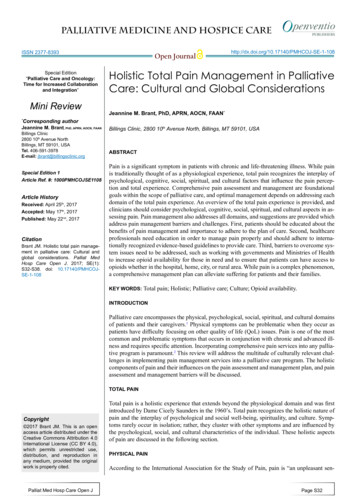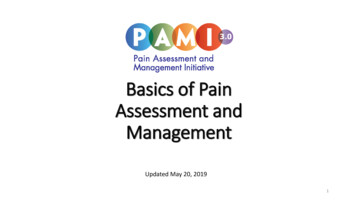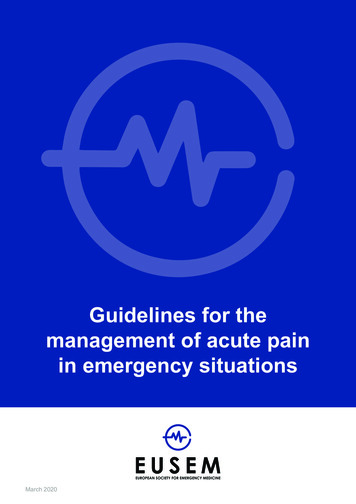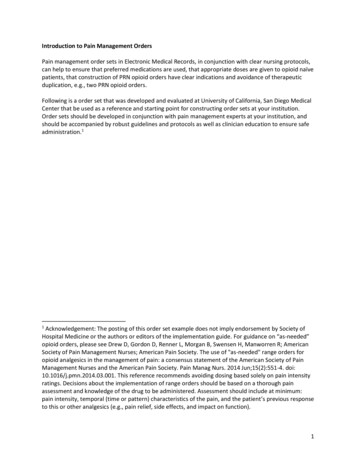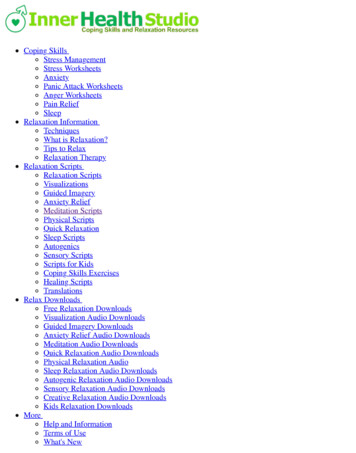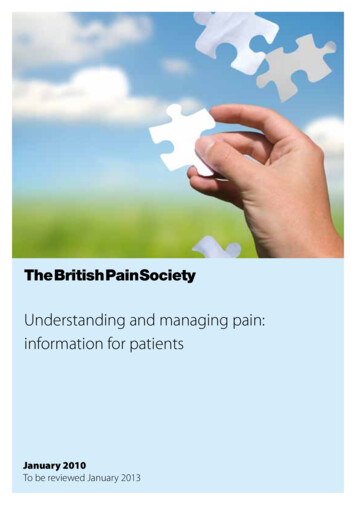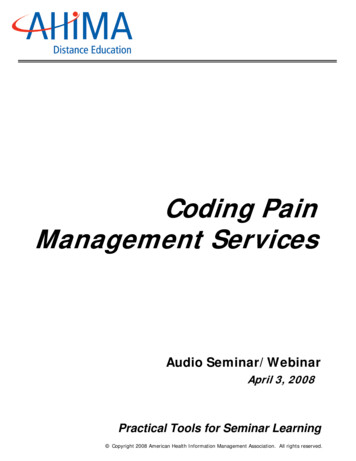
Transcription
Coding PainManagement ServicesAudio Seminar/WebinarApril 3, 2008Practical Tools for Seminar Learning Copyright 2008 American Health Information Management Association. All rights reserved.
DisclaimerThe American Health Information Management Association makes norepresentation or guarantee with respect to the contents herein and specificallydisclaims any implied guarantee of suitability for any specific purpose. AHIMA hasno liability or responsibility to any person or entity with respect to any loss ordamage caused by the use of this audio seminar, including but not limited to anyloss of revenue, interruption of service, loss of business, or indirect damagesresulting from the use of this program. AHIMA makes no guarantee that the useof this program will prevent differences of opinion or disputes with Medicare orother third party payers as to the amount that will be paid to providers of service.CPT five digit codes, nomenclature, and other data are copyright 2007 AmericanMedical Association. All Rights Reserved. No fee schedules, basic units, relativevalues or related listings are included in CPT. The AMA assumes no liability for thedata contained herein.As a provider of continuing education, the American Health InformationManagement Association (AHIMA) must assure balance, independence, objectivityand scientific rigor in all of its endeavors. AHIMA is solely responsible for control ofprogram objectives and content and the selection of presenters. All speakers andplanning committee members are expected to disclose to the audience: (1) anysignificant financial interest or other relationships with the manufacturer(s) orprovider(s) of any commercial product(s) or services(s) discussed in an educationalpresentation; (2) any significant financial interest or other relationship with anycompanies providing commercial support for the activity; and (3) if thepresentation will include discussion of investigational or unlabeled uses of aproduct. The intent of this requirement is not to prevent a speaker withcommercial affiliations from presenting, but rather to provide the participants withinformation from which they may make their own judgments.The faculty has reported no vested interests or disclosures regarding thispresentation.AHIMA 2008 Audio Seminar SeriesCPT Codes Copyright 2007 by AMA. All Rights Reservedi
FacultyMichelle Harder, RHIT, CCSMs. Harder has been a consultant with 3M Health Information Consulting Services sinceNovember 2002. She is responsible outpatient coding validation audits, coder education, andambulatory prospective payment billing audits as well as physician service reviews. In additionMichelle answers client questions regarding coding, billing and charging in the outpatient arena.She has fifteen years of specialized coding experience in the areas of emergency medicine,ambulatory surgery, and ancillary services. Her previous professional experience includescoding, data analysis, statistical reporting, and documentation compliance.Ms. Harder holds a Bachelor of Arts degree in Business Administration from Eastern WashingtonUniversity and an Associate of Science Degree in Health Information Technology from SpokaneCommunity College. She is a member in good standing with American Health InformationManagement Association, North Carolina Health Information Management Association and TheAmerican Academy of Professional Coders.Robert C. Holdenwang, RHIARob is a Senior Manager with 3M Health Information Systems, Consulting Services in Atlanta.Rob has greater than 25 years experience in Health Information Management, managing underdifferent levels of management in facilities ranging from 200 beds to 1450 beds for for-profit,non-profit, and teaching institutions.Rob has experience in Health Information Management Departments including coding,abstracting, transcription, tumor registry, corporate compliance, and quality management. Hehas also implemented and converted several systems including Transcription, Coding, MasterPatient Index, and Hospital Wide Systems. He has prepared for regulatory surveys such asHCFA, Joint Commission and Tumor Registry. He has led teams on Confidentiality, Ethics, andTeam Building issues.Preparation of Seminar MaterialsAudrey G. Howard, RHIAAudrey is a Senior Consultant with 3M Health Information Systems, Consulting Services (3MHIS/CS). She has consulted on numerous healthcare engagements nationally involving codingvalidations, coding education, coding process improvement, quality and compliance reviews aswell as participating in the delivery of 3M’s concurrent DRG ASSURANCE program. She isresponsible for performing coding research and providing support for client coding questions.Audrey resides on 3M HIS/CS coding roundtable and also contributes to 3M HIS/CS QuarterlyNewsletter. In addition, she researches and develops numerous training materials andmanuals. Audrey also authors coding columns in the For the Record publication.Audrey has over 16 years of experience in Health Information Management. During herprofessional career, she has functioned as a coder, senior DRG technician, coding supervisor,assistant director of a Health Information Management Department and consultant. Her dutiesas assistant director included daily operations, managing bill hold, educating coding staff, andsupervising release of information. As assistant director, she also computerized the codingprocess and streamlined the workflow. Her teaching experience includes advanced codingclasses and documentation programs related to reimbursement, coding, compliance, severityand risk profiling. Audrey has worked with very large university hospitals, as well as multihospital systems to implement documentation improvement programs.Audrey is a Registered Health Information Administrator. She earned her Bachelor of Sciencedegree in Health Information Management from the University of Kansas in Lawrence, Kansas.AHIMA 2008 Audio Seminar SeriesCPT Codes Copyright 2007 by AMA. All Rights Reservedii
Table of ContentsDisclaimer . iFaculty .iiSeminar Objectives . 1Acute vs. Chronic Pain . 1Codes for Common Pain Conditions . 3ICD-9-CM Diagnostic Codes . 3Coding Guidelines for PainPain – Category 338 . 6Polling Question .14Pain Management ProceduresCPT Coding.15Injections .16Polling Question .20Destruction b Neurolytic Agent .23Intrathecal Catheters and Pain Pumps .25Neurostimulators – Spinal .27Epidural Adhesiolysis .28IDET – Intradiscal Electrothermal Therapy .29Post Operative Pain Management.30Polling Question .31References .31Audience QuestionsAppendixCE Certificate Instructions .36AHIMA 2008 Audio Seminar Series
Coding Pain Management ServicesNotes/Comments/QuestionsObjectivesDiscuss types of conditions thatrequire pain management services Discuss pain management procedures Review ICD-9-CM and CPT codesrelated to pain management Review coding guidelines related topain management services 12Acute vs. Chronic Pain2AHIMA 2008 Audio Seminar SeriesCPT Codes Copyright 2007 by AMA. All Rights Reserved1
Coding Pain Management ServicesNotes/Comments/QuestionsAcute vs. Chronic Pain Acute pain: Begins suddenlySharp feelingRange from mild to severeLasts a few minutes or a few weeks or months Typically does not last longer than six months Resolved when the underlying cause of the painis identified and treated May be caused by one of the following: SurgeryFractured bonesDental workBurns or cutsLabor/childbirth3Acute vs. Chronic Pain Chronic pain: May be caused from unrelieved acute pain May persist even though the underlying injuryhas healed Common effects of chronic pain may include: Tense musclesLimited mobilityLack of energyChange in appetiteDepressionAngerAnxiety4AHIMA 2008 Audio Seminar SeriesCPT Codes Copyright 2007 by AMA. All Rights Reserved2
Coding Pain Management ServicesNotes/Comments/QuestionsCodes for Common Pain Conditions Dorsopathies Section Categories 720-724 include spinal stenosis, herniated intervertebral discs,degenerative disc disease, radiculopathies, andsacroiliitis RSD reflex sympathetic dystrophy 337.29 Trigeminal neuralgia 350.1 Trigeminal neuralgia 350.2 Atypical face pain 053.12 Postherpetic trigeminal neuralgia56ICD-9-CM Diagnostic Codes6AHIMA 2008 Audio Seminar SeriesCPT Codes Copyright 2007 by AMA. All Rights Reserved3
Coding Pain Management ServicesNotes/Comments/QuestionsICD-9-CM Diagnostic Codes Conditions classified to category 338,Pain, not elsewhere classified: 338.0, Central pain syndromeDejerine-Roussy syndromeMyelopathic pain syndromeThalamic pain syndrome (hyperesthetic) 338.11, Acute pain due to trauma 338.12, Acute post-thoracotomy painPost-thoracotomy pain NOS7ICD-9-CM Diagnostic Codes Conditions classified to category 338,Pain, not elsewhere classified: 338.18, Other acute postoperative painPostoperative pain NOS 338.19, Other acute pain338.21, Chronic pain due to trauma338.22, Chronic post-thoracotomy pain338.28, Other chronic postoperative pain338.29, Other chronic pain8AHIMA 2008 Audio Seminar SeriesCPT Codes Copyright 2007 by AMA. All Rights Reserved4
Coding Pain Management ServicesNotes/Comments/QuestionsICD-9-CM Diagnostic Codes Conditions classified to category 338,Pain, not elsewhere classified: 338.3, Neoplasm related pain (acute)(chronic)Cancer associated painPain due to malignancy (primary) (secondary)Tumor associated pain 338.4, Chronic pain syndromeChronic pain associated with significantpsychosocial dysfunction9ICD-9-CM Diagnostic Codes Generalized pain (780.96) is assignedto classify unspecified pain10AHIMA 2008 Audio Seminar SeriesCPT Codes Copyright 2007 by AMA. All Rights Reserved5
Coding Pain Management ServicesNotes/Comments/Questions11Coding Guidelines for PainNote:Applies to all health care settings11Coding GuidelinesPain – Category 338 It is appropriate to assign codes from othercategories and chapters with codes fromcategory 338 to further identify the acuteor chronic pain and the neoplasm-relatedpain, unless otherwise indicated in theseguidelines.AHA Coding Clinic for ICD-9-CM, 2007, fourth quarter, pages 158-16212AHIMA 2008 Audio Seminar SeriesCPT Codes Copyright 2007 by AMA. All Rights Reserved6
Coding Pain Management ServicesNotes/Comments/QuestionsCoding GuidelinesPain – Category 338 Do not assign codes from category 338 ifthe pain is not specified as acute orchronic, except for post-thoracotomy pain,postoperative pain, neoplasm related pain,or central pain syndrome.AHA Coding Clinic for ICD-9-CM, 2007, fourth quarter, pages 158-16213Coding GuidelinesPain – Category 338 Do not assign a code from subcategories 338.1and 338.2 if the underlying (definitive) diagnosisis known, unless the reason for the encounter ispain control/management and not managementof the underlying condition. Note: The term “encounter” is used for allsettings, including hospital admissionsAHA Coding Clinic for ICD-9-CM, 2007, fourth quarter, pages 158-16214AHIMA 2008 Audio Seminar SeriesCPT Codes Copyright 2007 by AMA. All Rights Reserved7
Coding Pain Management ServicesNotes/Comments/QuestionsCoding Guidelines A code from category 338 should be sequenced asprincipal diagnosis or first-listed code when: The reason for admission is for pain control or painmanagement Code the underlying cause of the pain as a secondarydiagnosis The reason for admission is for insertion of aneurostimulator for pain control If admission is for a procedure aimed at treating theunderlying condition and a neurostimulator is insertedduring the same admission, assign a code for the underlyingcondition should be sequenced as the principal diagnosis orfirst-listed code– Assign the appropriate pain code as a secondarydiagnosisAHA Coding Clinic for ICD-9-CM, 2007, fourth quarter, pages 158-16215Coding GuidelinesPain – Category 338 A code for the underlying condition will besequenced as the principal diagnosis orfirst-listed code when a patient is admittedfor a procedure aimed at treating theunderlying condition Do not assign a code from category 338 in thissituationAHA Coding Clinic for ICD-9-CM, 2007, fourth quarter, pages 158-16216AHIMA 2008 Audio Seminar SeriesCPT Codes Copyright 2007 by AMA. All Rights Reserved8
Coding Pain Management ServicesNotes/Comments/QuestionsCoding GuidelinesPain – Category 338 It is appropriate to assign a code fromcategory 338 with another site-specificcode if the code from category 338provides additional information.AHA Coding Clinic for ICD-9-CM, 2007, fourth quarter, pages 158-16217Coding Guidelines Sequencing of these two codes will depend on thecircumstances of admission with the following twoexceptions: If the reason for admission is for paincontrol/management, then the code from category 338 issequenced as principal diagnosis or first-listed codefollowed by the site-specific pain code. If the reason for admission is for any other reason otherthan pain control/management and a related definitivediagnosis has not been established, then the site-specificpain code will be sequenced as the principal diagnosis orfirst-listed code with the code from category 338sequenced as a secondary diagnosis.AHA Coding Clinic for ICD-9-CM, 2007, fourth quarter, pages 158-16218AHIMA 2008 Audio Seminar SeriesCPT Codes Copyright 2007 by AMA. All Rights Reserved9
Coding Pain Management ServicesNotes/Comments/QuestionsCoding GuidelinesPain – Category 338 Pain due to a device, implant and graft isassigned to the appropriate code fromChapter 17, Injury and Poisoning Assign a code from category 338 to identify ifpain is acute or chronicAHA Coding Clinic for ICD-9-CM, 2007, fourth quarter, pages 158-16219Coding GuidelinesPain – Category 338 There is no time frame that identifies whenthe pain can be defined as chronic Code assignment is based on physician’sdocumentationAHA Coding Clinic for ICD-9-CM, 2007, fourth quarter, pages 158-16220AHIMA 2008 Audio Seminar SeriesCPT Codes Copyright 2007 by AMA. All Rights Reserved10
Coding Pain Management ServicesNotes/Comments/QuestionsCoding GuidelinesPain – Category 338 The diagnosis of chronic pain syndrome isnot the same as chronic pain. Assign thecode for chronic pain syndrome only whenthat diagnosis has been documented bythe physicianAHA Coding Clinic for ICD-9-CM, 2007, fourth quarter, pages 158-16221Coding GuidelinesPain – Category 338 Postoperative pain and post-thoracotomypain not specified as acute or chronicdefaults to the code for the acute type. Do not assign a code for the postoperative painif it is routine or expected after surgery Assign a code from category 338 whenpostoperative pain is not associated with aspecific postoperative complicationAHA Coding Clinic for ICD-9-CM, 2007, fourth quarter, pages 158-16222AHIMA 2008 Audio Seminar SeriesCPT Codes Copyright 2007 by AMA. All Rights Reserved11
Coding Pain Management ServicesNotes/Comments/QuestionsCoding GuidelinesPain – Category 338 If postoperative pain is associated with aspecific postoperative complication,assign the appropriate code fromChapter 17 Assign a code from category 338 to identify ifpain is acute or chronic, if appropriateAHA Coding Clinic for ICD-9-CM, 2007, fourth quarter, pages 158-16223Coding GuidelinesPain – Category 338 Sequence the postoperative pain code as theprincipal diagnosis or first-listed code when thepatient is admitted for postoperative paincontrol or pain management Sequence the postoperative pain code as asecondary diagnosis when the patient develops“unusual or inordinate amount of postoperativepain” after outpatient surgeryAHA Coding Clinic for ICD-9-CM, 2007, fourth quarter, pages 158-16224AHIMA 2008 Audio Seminar SeriesCPT Codes Copyright 2007 by AMA. All Rights Reserved12
Coding Pain Management ServicesNotes/Comments/QuestionsCoding Guidelines Neoplasmrelated pain Assign code 338.3, Neoplasm related pain, for apatient that has pain that is related to, associatedwith, or due to cancer (either primary orsecondary) or tumor regardless if the pain isacute or chronic. Code 338.3 includes: Cancer associated pain Pain due to malignancy (primary) (secondary) Tumor associated paincontinued on next slide25Coding Guidelines Neoplasmrelated pain (continued) Code 338.3 is sequenced as the principaldiagnosis or first-listed code if the reason foradmission is for pain control/management Assign a code for the malignancy as a secondarydiagnosis Code 338.3 may be sequenced as a secondarydiagnosis if the reason for admission is formanagement of the neoplasm and the neoplasmrelated pain is also documentedAHA Coding Clinic for ICD-9-CM, 2007, fourth quarter, pages 158-16226AHIMA 2008 Audio Seminar SeriesCPT Codes Copyright 2007 by AMA. All Rights Reserved13
Coding Pain Management ServicesNotes/Comments/QuestionsPolling QuestionA patient is admitted with severe low backpain which has been getting progressivelyworse over the last 6 months. After study,the physician documents the pain is due tolumbar stenosis. The patient is treated withpain medication during this admission andwill be scheduled for surgery soon.27Polling QuestionWhich of the following codes should besequenced as the principal diagnosis?*1*2*3*4724.2, Low back pain (lumbago)338.19, Acute pain724.02, Spinal stenosis of the lumbar region338.29, Chronic pain28AHIMA 2008 Audio Seminar SeriesCPT Codes Copyright 2007 by AMA. All Rights Reserved14
Coding Pain Management ServicesNotes/Comments/Questions29Pain Management ProceduresCPT Coding29Pain Management Procedures InjectionsDestruction by Neurolytic AgentIntrathecal Catheters with SubcutaneousPump Delivery SystemsSpinal NeurostimulatorsEpidural NeurolysisIDET – Intradiscal Electrothermal Therapy30AHIMA 2008 Audio Seminar SeriesCPT Codes Copyright 2007 by AMA. All Rights Reserved15
Coding Pain Management ServicesNotes/Comments/QuestionsInjections Questions to ask:When reporting spinal injections keep these key questions inmind and it will help you determine which series of codes touse.What is the approach? Epidural, transforaminal, facet What is being injected? Anesthetic, steroid, contrast, neurolytic agent What regions are treated? Regions: cervical, thoracic, lumbar, sacral How many levels are treated? Is it a unilateral or a bilateral injection? One or more than one level31Injections Epidural injectionsThe approach for an epidural injection is directly into theepidural space between vertebrae. The purpose is to relievecervical or neck pain; thoracic or midback pain; lumbar or lowback pain. Transforaminal injectionsThe approach for a transforaminal injection is by way of theintervertebral foramen. There are two foramen for eachvertebra on opposite sides of the spine. The needle is insertedto gain access to the epidural space and nerve root. Facet joint or facet joint nerve injectionsThe approach for facet injections are by way of theintravertebral facets. Each vertebra has four facets.Injections are performed to block the pain signals from thefacet joint of the spine and associated nerves to the brain.AHIMA 2008 Audio Seminar SeriesCPT Codes Copyright 2007 by AMA. All Rights Reserved3216
Coding Pain Management ServicesNotes/Comments/QuestionsInjectionsEpidural injectionsInjection single of diagnostic or therapeutic, epidural orsubarachnoid;62310cervical or thoracic62311lumbar, sacral (caudal) Medication is administered with needle injection into theepidural space. Injection procedures are considered unilateral and shouldbe reported once per level per side.Reference: AMA CPT Assistant, November 1999. Multiple injections at the same level on the same side arereported one time only33Injections Epidural injections by infusion or bolus 62318Injection, including catheter placement,continuous infusion or intermittent bolus notincluding neurolytic substances with or withoutcontrast (for either localization or epidurography)of diagnostic or therapeutic substance(s)(including anesthetic antispasmodic opioid,steroid, other solution), epidural or subarachnoid;cervical or thoracic62319lumbar, sacral (caudal)Medication is administered by infusion or bolusCatheter placement is in included in these codes 34AHIMA 2008 Audio Seminar SeriesCPT Codes Copyright 2007 by AMA. All Rights Reserved17
Coding Pain Management opy and EpidurographyFluoroscopy 77003 Fluoroscopic guidance and localization of needle orcatheter tip for spine or paraspinous diagnostic ortherapeutic injection procedures (epidural, transforaminalepidural, subarachnoid, paravertebral facet joint,paravertebral facet joint nerve or sacroiliac joint), includingneurolytic agent destructionReport any fluoroscopic guidance necessary for placement ofthe needle.Epidurography 72275 Epidurography, radiological supervision andinterpretationIf epidurography is performed report only if the images aredocumented and formal radiological report is given.Fluoroscopy would not be reported when performed with theepidurography.35ExampleThe patient was placed in a prone position.Using fluoroscopic guidance a 18-gageTuohy needle was placed in the L4 – L5vertebral interspace. Injected contrastconfirmed accurate placement of theneedle. Then a mixture of Depo Medrol80 mg, normal saline 10 cc and lidocaine1% at 5 cc was injected with good results.CPT code assignment: 62311, 7700336AHIMA 2008 Audio Seminar SeriesCPT Codes Copyright 2007 by AMA. All Rights Reserved18
Coding Pain Management aminal epidural injections Report modifier 50 for bilateralinjections at the same levelReport each level that an injectionis givenReport codes appropriate for thetreated region of the spineFluoroscopic guidance necessary forplacement of the needle (77003)would also be reported.Physician codingInjection,anestheticagent and/orsteroid,transforaminalepidural;cervical orthoracicsingle level64479Lumbar orsacralsingle level64483 Do not report modifier 51 with theadd on codes for additional levelseachadditionallevel 64480eachadditionallevel 6448437ExamplePatient was placed in prone position.Prepped and draped in usual sterilefashion. Needles were introduced into theleft epidural space through theintervertebral foramen at C2-C3 and C3-C4levels. Fluoroscopic guidance and contrastinjection confirmed needle placements. Amixture of Depo-Medrol and lidocaine wasinjected at both levels with excellentresults. Code assignment 64479-LT, 64480-LT, 7700338AHIMA 2008 Audio Seminar SeriesCPT Codes Copyright 2007 by AMA. All Rights Reserved19
Coding Pain Management ServicesNotes/Comments/QuestionsInjectionsFacet joint or joint nerve injection Report modifier 50 for bilateralinjections at the same levelReport each level that aninjection is givenReport codes appropriate forthe treated region of the spineFluoroscopic guidance necessaryfor placement of the needle(77003) would also be reported.Physician codingInjection,anestheticagent and/orsteroid,paravertebralfacet joint orfacet jointnerve; cervicalor thoracicsingle level64470lumbar orsacralsingle level64475 Do not report modifier 51 withthe add on codes for additionallevelseachadditionallevel 64472eachadditionallevel 6447639Polling questionThis Medicare patient is given facet jointinjections of the lumbar spine at the L2, L3,and L4 levels bilaterally. Fluoroscopicguidance is used. What codes should bereported for the 50,77003-2664484-50, 64484-50, 7700364476-50, 64476-50, 7700362311-50, 62311-50, 7700364476-50-51, 64476-50-51,AHIMA 2008 Audio Seminar SeriesCPT Codes Copyright 2007 by AMA. All Rights Reserved4020
Coding Pain Management ServicesNotes/Comments/QuestionsInjectionsTrigger point injections Trigger point is an area of soft tissue or surrounding musclethat is painful. Anesthetic and/or steroid are injected in thearea to relieve pain. The description may include “injectionsadministered by fan technique”.Injection(s); single or multiple trigger point(s), 20552 one or two muscles 20553 three or more muscles Report one code per session based on the number of musclesinjected not the number of injections given.20552 and 20553 would not be reported together.Report fluoroscopic needle placement guidance with 77002 41InjectionsSacroiliac Joint Injections The sacroiliac joint connects the sacrum to thepelvis. The injection alleviates pain most oftenproduced by sacroiliitis.In order to report these procedures correctlyanswer the following questions: Is the procedure performed in an OPPS hospitalor ASC? Is the patient’s primary payer Medicare? Is the purpose of the injection to inject asteroid or anesthetic (therapeutic) or toperform arthrography (diagnostic)? Is the injection unilateral or bilateral?42AHIMA 2008 Audio Seminar SeriesCPT Codes Copyright 2007 by AMA. All Rights Reserved21
Coding Pain Management ac Joint Injections Facility Hospitals and ASCs must report these injections forMedicare patients with HCPC level II CodesInjection procedure for sacroiliac joint; G0259 arthrography 73542 sacroiliac joint arthrography should also be reported Separate fluoroscopic guidance would not be reported inaddition to the arthrography G0260 provision of anesthetic, steroid and/or othertherapeutic agent, with or without arthrography 77003 for the fluoroscopic guidance if performed withoutarthrography and 73542 if performed with arthrography(77003 would not be reported if arthrography is performed). Report modifier 50 for bilateral injections43InjectionsSacroiliac Joint Injections Physician 27096 Injection procedure for sacroiliac joint,arthrography and/or anesthetic/steroid If the purpose of the injection was for arthrographythen the injection code 27096 would be reported withthe radiological examination using 73542-26. Fluoroscopy would not be reported in addition to thearthrography. If the purpose of the injection was fortherapeutic purposes report 27096 and thefluoroscopic guidance 77003-26.44AHIMA 2008 Audio Seminar SeriesCPT Codes Copyright 2007 by AMA. All Rights Reserved22
Coding Pain Management ServicesNotes/Comments/QuestionsDestruction by Neurolytic AgentRadiofrequency ablation proceduresare reported with the appropriatedestruction codes. “Neurolytic agent”includes chemical, thermal, electricalor radiofrequency. Paravertebral Facet Trigeminal 45Destruction by Neurolytic AgentParavertebral facetradiofrequency ablation. Report modifier 50 for bilateralinjections at the same level Report each level that in injectionis given Report codes appropriate for theregion of the spineDestructionby neurolyticagent;cervical orthoracicsingle level64626eachadditionallevel 64627lumbar orsacralsingle level64622eachadditionallevel 64623Fluoroscopic guidance necessary forplacement of the needle (77003)would also be reported.Coding for physician do not reportmodifier 51 with the add on code foradditional levels.46AHIMA 2008 Audio Seminar SeriesCPT Codes Copyright 2007 by AMA. All Rights Reserved23
Coding Pain Management ServicesNotes/Comments/QuestionsDestruction by Neurolytic Agent Trigeminal rhizotomy may be performed byradiofrequency ablation or by neurolytics.Trigeminal ablations are performed to treattrigeminal neuralgia or tic douloureux. This is acondition of the fifth cranial nerve thought to because by compressive venous or arterial loops inthe face. The intense pain caused by this conditionis often triggered by activities such as chewing orteeth brushing. It is sometimes referred to as the“suicide disease” because patients are driven totake their own life due to intense pain and failureto obtain effective treatment.47Destruction by Neurolytic Agent Destruction by neurolytic agent trigeminalnerve; 64600supraorbital, infraorbital mental orinferior alveolar 64605second and third division at theforamen ovale 64610second and third division at theforamen ovale with radiologicmonitoring Report modifier 50 for bilateral injections at thesame level48AHIMA 2008 Audio Seminar SeriesCPT Codes Copyright 2007 by AMA. A
the pain is not specified as acute or chronic, except for post-thoracotomy pain, postoperative pain, neoplasm related pain, or central pain syndrome. AHA Coding Clinic for ICD-9-CM , 2007, fourth quarter, pages 158-162 13 Coding Guidelines Pain - Category 338 Do not assign a code from subcategories 338.1



